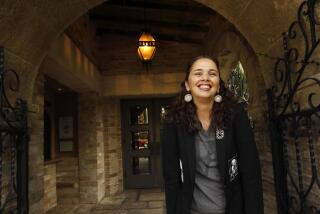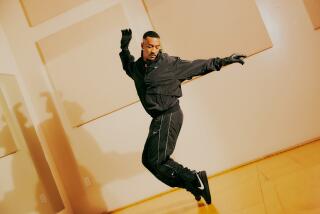Twyla Tharp Moves to Hubbard Street : The choreographer entrusts three early pieces to the Chicago dance company
CHICAGO — “One, two--wait!”
Choreographer Twyla Tharp stopped the action almost immediately after it had begun.
“I should feel the feet are reluctant to get off the floor,” she told the dancers. “I should feel. . .”--she slid her hands against each other--”. . . that .”
Members of the Hubbard Street Dance Company returned to their initial positions, concentrating intently on clearing their minds. “Let’s consider this concept that’s called ‘natural,’ ” Tharp said. “Let’s see natural.”
It was July in the company’s studio in downtown Chicago. A few months earlier, Tharp had announced that the 16-member company would for three years become the repository for three of her earlier pieces: “The Fugue” (1970), “Sue’s Leg” (1975) and “Baker’s Dozen” (1979). The company’s Thursday-Saturday programs at Irvine Barclay Theatre will include “Sue’s Leg,” which will also be performed--along with “Baker’s Dozen”--at UCLA’s Royce Hall, Feb. 1-2. “The Fugue” can be seen at Smothers Theatre, Pepperdine University, on Feb. 4-5.
Hubbard Street’s “Tharp Project,” a $300,000 collaboration, marked the first time the choreographer has worked with a modern dance company since she dismantled her own troupe in 1988. It was also a coup for the company, which began performing in senior-citizen cafeterias in 1979 and now is internationally respected for showcasing the works of such contemporary American choreographers as Margo Sappington, Daniel Ezralow and Hubbard Street founder and artistic director Lou Conte.
Upon establishing her relationship with Hubbard Street, Tharp praised the troupe’s “honesty” and Midwestern work ethic. A few of her former dancers actually taught the pieces to the dancers, but Tharp herself would drop in every week or so to check the group’s progress and to drill them with what you might call Socratic dance instruction--except that she can be as quick with the answers as with the questions.
“Greek columns look straight from a distance. Why? Because they’re curved,” said Tharp, a tightly spun bundle of energy in her bleached jeans and tortoise-shell glasses. “If they were straight they’d look curved. You have to find the image, the illusion of relaxed.”
The dancers, working in groups of three, were rehearsing the seemingly unstructured but actually intricate steps of “The Fugue.” No movement was too small to go unnoticed.
“It’s not jamming your feet into the ground. It’s dropping your feet onto it.
“You’re not getting enough resistance. There’s not enough isometric pressure there.
“You’ve got to be wearing heavy shoes. Underneath those shoes I have to be able to feel your toes.”
After one dancer landed too heavily, Tharp said, “This dance has nothing to do with anger. It has to do with power and weight and mass.”
The feedback was constant but never hostile or threatening. Her passion for detail was complete and rubbed off on the dancers.
“She is very direct, and she doesn’t miss a thing,” said Hubbard Street dancer Frank Chaves. “She just had wonderful amounts of information to give everyone. Two counts would go by, and then she’d say ‘Stop’ and have 10 things to say. She demands quite a lot from you upstairs as well as from the body.”
Although at one point Tharp declared that “thinking and dancing simultaneously was never something God intended us to do,” she constantly strives to integrate the body and mind.
“What’s the key word to this dance? Freedom, and that’s also an illusion.
“See if you can literally control the flow of adrenaline in your bodies.
“You look kaflutzed--do you know what that means?”
While trying to explain a certain movement, Tharp said, “It’s like the universe. We are still trying to figure out whether there are rules that govern the universe.”
She turned aside and added, “It’s terrifying what dance is about, isn’t it?”
Claire Bataille, who has danced with Hubbard Street since its formation, said that her fantasy had been to work with Tharp and that “it lived up to all my expectations. She’s a very positive person,” Bataille said. “She’s very demanding but she’s not demeaning at all. Her work ethics are so pure--it was all about the work and accomplishing something. She’s someone who really has a clear vision of movement and what she wants her audience and her dancers to get out of her choreography.”
Bataille added that she thinks the union of Tharp and Hubbard Street has been fitting. “I think (the Tharp pieces) have a kind of accessibility that’s always been a feature of Hubbard St. works, and they give the dancers a lot of satisfaction, which tends to give the audience a lot of satisfaction.”
Chaves agreed. “ ‘Baker’s Dozen’ is very, very Hubbard Street. It fits us so well that it looks like it could have been an original work for us. It’s very dancy and with a lot of movement, but there’s also a lot of ballet technique in it.”
Hubbard Street unveiled its stagings of “The Fugue” and “Sue’s Leg” in August at Jacob’s Pillow Dance Festival in Massachusetts, and “Baker’s Dozen” bowed on the group’s recent European tour. The company now hopes that the positive reviews and Tharp’s experience with the group will encourage her to consider Hubbard Street a “natural” home for further works--old and new.
More to Read
The biggest entertainment stories
Get our big stories about Hollywood, film, television, music, arts, culture and more right in your inbox as soon as they publish.
You may occasionally receive promotional content from the Los Angeles Times.










